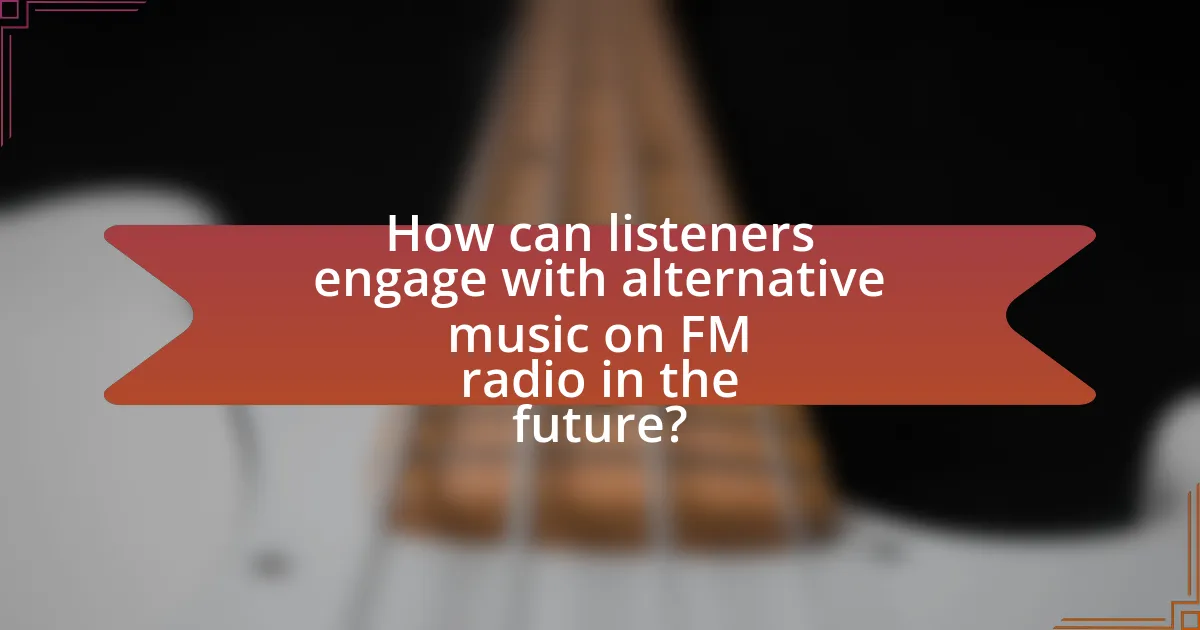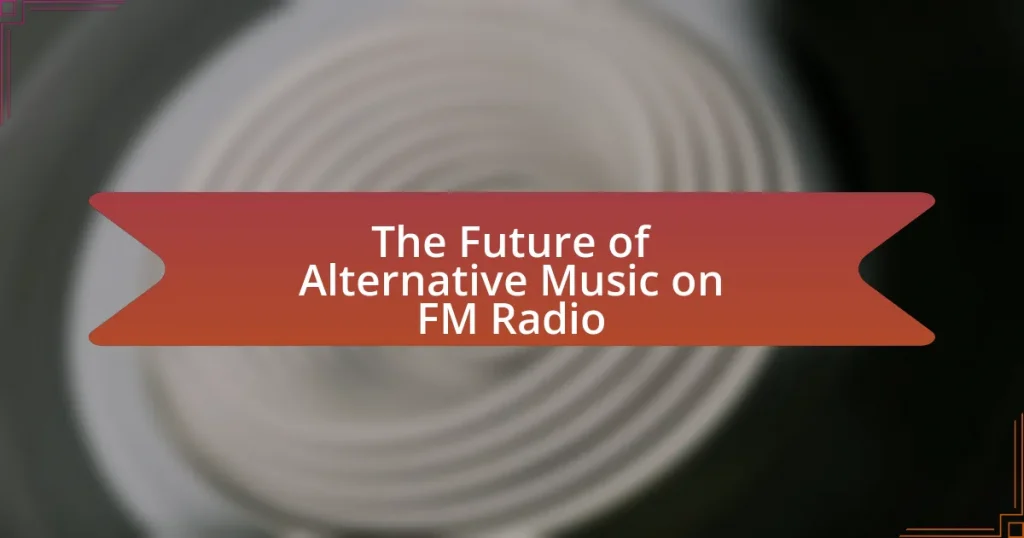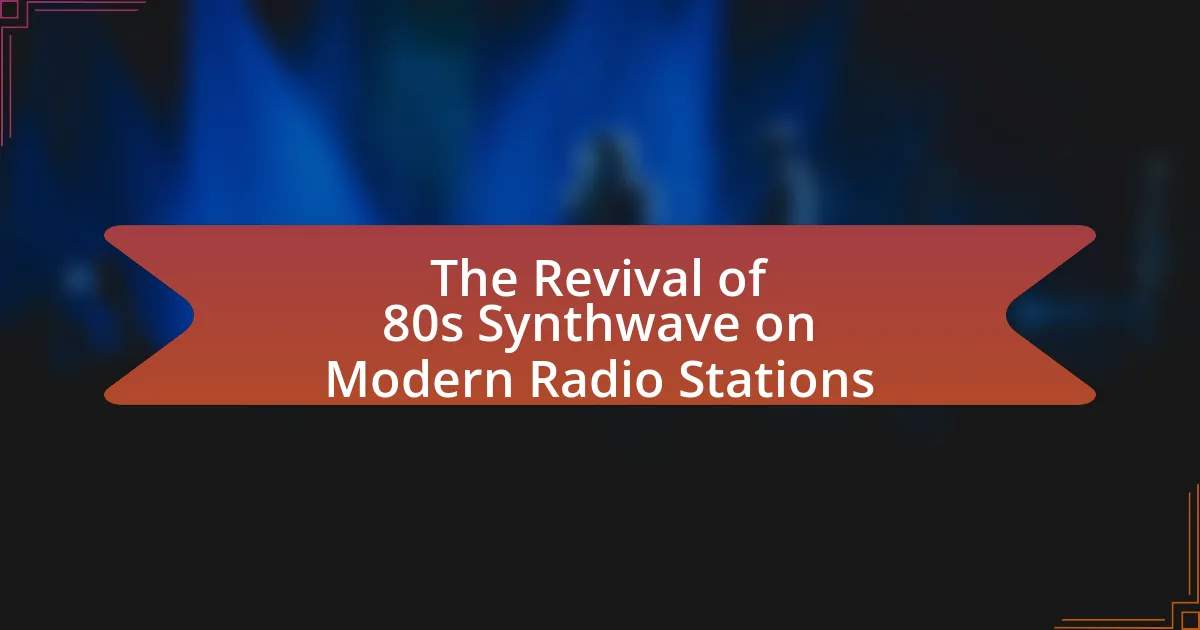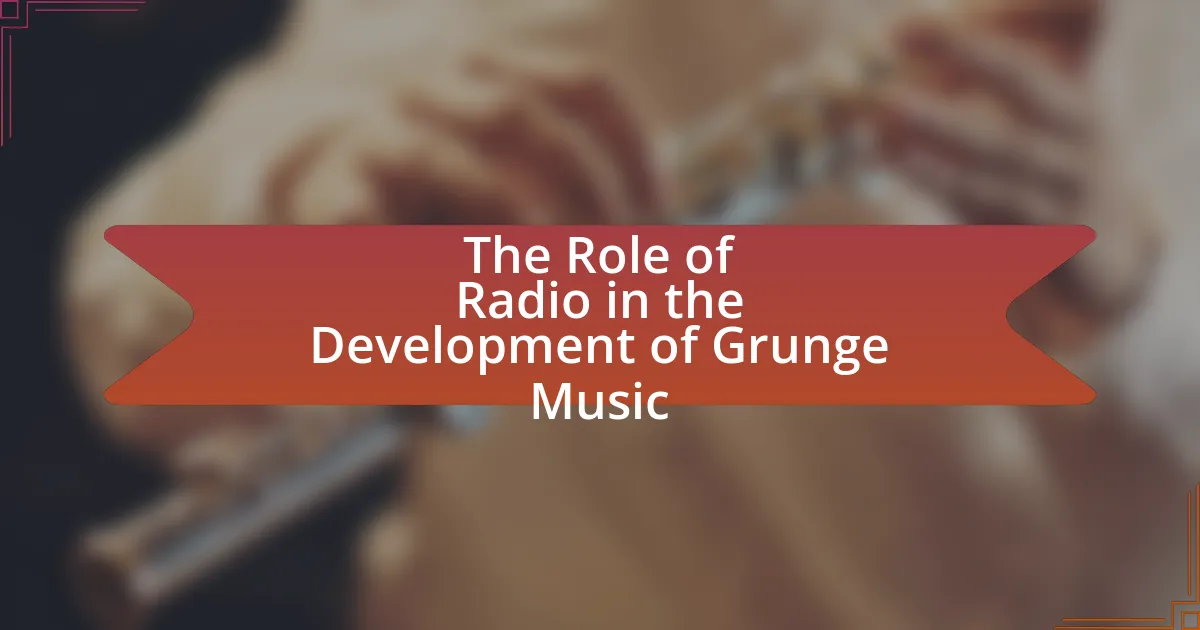The article examines the future of alternative music on FM radio, highlighting the decline of traditional airplay as digital platforms become more prevalent. It defines alternative music within the FM context, detailing its diverse genres and historical significance, while also discussing the evolving listener demographics and the impact of technology on radio programming. The challenges faced by alternative music, including commercial pressures and limited airtime, are analyzed, alongside strategies FM stations can adopt to support the genre. Additionally, the article explores how listeners can engage with alternative music on FM radio and the mechanisms available for influencing programming decisions.

What is the Future of Alternative Music on FM Radio?
The future of alternative music on FM radio is likely to see a decline in traditional airplay as digital platforms gain dominance. As streaming services and online radio become more popular, FM radio stations are struggling to attract younger audiences who prefer on-demand content. According to a 2021 Nielsen report, 62% of Gen Z listeners use streaming services as their primary source for music, indicating a shift away from FM radio. This trend suggests that while alternative music may still have a presence on FM, its reach and influence will diminish as listeners increasingly turn to digital mediums for their music consumption.
How is alternative music defined in the context of FM radio?
Alternative music is defined in the context of FM radio as a genre that encompasses a diverse range of sounds and styles that deviate from mainstream pop music. This genre often includes independent artists and bands that prioritize artistic expression over commercial success, reflecting a variety of influences from punk, rock, and electronic music. Historically, FM radio stations have played a crucial role in promoting alternative music, especially since the 1980s, when college radio began to feature these artists, providing them with a platform to reach wider audiences. This support has contributed to the growth of alternative music as a significant cultural movement, influencing both the music industry and listener preferences.
What genres are included under the umbrella of alternative music?
Alternative music encompasses a variety of genres including indie rock, grunge, post-punk, new wave, shoegaze, and alternative pop. These genres emerged as distinct styles that diverged from mainstream music trends, particularly in the 1980s and 1990s, with bands like R.E.M. and Nirvana playing pivotal roles in popularizing alternative music. The diversity within alternative music reflects a wide range of influences and experimentation, making it a dynamic and evolving genre.
How has the definition of alternative music evolved over time?
The definition of alternative music has evolved from a label primarily used in the 1980s to describe underground rock bands to a broader genre encompassing diverse styles and influences. Initially, alternative music referred to bands that deviated from mainstream pop and rock, such as R.E.M. and The Smiths, who gained popularity in the college radio scene. Over time, the term expanded to include various subgenres, including grunge, indie rock, and electronic influences, reflecting changes in cultural tastes and technological advancements. By the 2000s, alternative music had become a mainstream category, with artists like Radiohead and Coldplay achieving significant commercial success, illustrating its transformation from a niche genre to a dominant force in popular music.
What trends are shaping the future of alternative music on FM radio?
The future of alternative music on FM radio is being shaped by the rise of digital streaming platforms, which are influencing listener preferences and radio programming. As more listeners turn to platforms like Spotify and Apple Music, FM radio stations are adapting by incorporating playlists that reflect popular streaming trends, often featuring emerging artists and diverse genres. Additionally, the integration of social media allows for real-time audience engagement, enabling stations to curate content that resonates with their listeners. According to a 2022 Nielsen report, 63% of radio listeners also use streaming services, indicating a significant overlap that FM stations are leveraging to stay relevant in a changing music landscape.
How are listener demographics changing for alternative music?
Listener demographics for alternative music are shifting towards a more diverse age range and increased representation of various ethnic backgrounds. Recent studies indicate that younger listeners, particularly those aged 18-24, are increasingly engaging with alternative music, with a 2022 report from Nielsen Music showing a 15% rise in this age group’s consumption of alternative genres compared to previous years. Additionally, the genre is attracting a broader audience, with a notable increase in listeners from multicultural backgrounds, reflecting a 20% growth in non-white listeners over the past five years, as reported by the Pew Research Center. This demographic shift is influencing the types of artists and sounds that gain popularity within the alternative music scene.
What role does technology play in the evolution of FM radio for alternative music?
Technology has significantly transformed FM radio’s role in promoting alternative music by enhancing accessibility, improving sound quality, and enabling innovative programming. The advent of digital broadcasting technologies, such as HD Radio, has allowed FM stations to transmit higher fidelity audio, which is crucial for the nuanced sound of alternative music genres. Additionally, streaming services and online platforms have integrated with FM radio, allowing listeners to access alternative music content anytime and anywhere, thus broadening the audience reach. According to a 2021 Nielsen report, 62% of listeners aged 18-34 engage with radio through digital platforms, indicating a shift in how alternative music is consumed. This technological evolution not only supports the dissemination of diverse musical styles but also fosters community engagement through social media and interactive platforms, allowing fans to connect with artists and each other.
Why is FM radio still relevant for alternative music today?
FM radio remains relevant for alternative music today because it provides a unique platform for niche genres that may not receive mainstream attention. This medium allows local stations to curate playlists that feature emerging artists and underground sounds, fostering community engagement and discovery. According to a 2022 Nielsen report, 92% of Americans still listen to radio weekly, highlighting its enduring reach. Additionally, FM radio’s ability to create a shared listening experience enhances the cultural significance of alternative music, as listeners connect over shared tastes and local events.
What unique advantages does FM radio offer to alternative music artists?
FM radio offers alternative music artists the unique advantage of reaching a broad and diverse audience through established broadcasting networks. This medium provides artists with the opportunity to gain exposure in local markets, where listeners often seek new and unique sounds. Additionally, FM radio stations frequently curate playlists that include alternative music, allowing artists to be featured alongside mainstream acts, which can enhance their credibility and visibility. According to a study by the Pew Research Center, radio remains a primary source of music discovery for many listeners, with 44% of adults stating they often discover new music through radio. This statistic underscores the potential for alternative music artists to connect with new fans through FM radio broadcasts.
How does FM radio contribute to the discovery of new alternative music?
FM radio contributes to the discovery of new alternative music by providing a platform for independent and emerging artists to reach a wider audience. This medium often features curated playlists that include lesser-known tracks, allowing listeners to encounter diverse sounds that may not be available on mainstream channels. According to a study by the Pew Research Center, 43% of Americans discover new music through radio, highlighting its role in music exploration. Additionally, FM radio stations frequently host local music showcases and interviews with artists, further promoting new talent and fostering community engagement in the alternative music scene.

What challenges does alternative music face on FM radio?
Alternative music faces significant challenges on FM radio, primarily due to limited airtime and commercial pressures. FM radio stations often prioritize mainstream genres that attract larger audiences and advertising revenue, resulting in reduced exposure for alternative music. According to a 2020 report by the Pew Research Center, only 15% of radio stations in the U.S. feature alternative music in their playlists, highlighting the genre’s marginalization. Additionally, the consolidation of radio ownership has led to a homogenization of content, further diminishing the diversity of music played on air. These factors collectively hinder the growth and visibility of alternative music within the FM radio landscape.
How do commercial interests impact the airplay of alternative music?
Commercial interests significantly impact the airplay of alternative music by prioritizing mainstream genres that attract larger audiences and advertising revenue. Radio stations, driven by profit motives, often favor popular music over alternative tracks, leading to reduced exposure for alternative artists. For instance, a study by the Pew Research Center found that commercial radio playlists are heavily influenced by market research, which typically favors established hits over emerging alternative sounds. This trend limits the diversity of music played on air and restricts the opportunities for alternative musicians to gain visibility and reach wider audiences.
What are the barriers for independent alternative music artists on FM radio?
Independent alternative music artists face several barriers on FM radio, primarily including limited access to airplay, lack of financial resources, and insufficient industry connections. Limited access to airplay occurs because many FM stations prioritize mainstream artists due to audience demand and advertising revenue, which often leads to a preference for established acts over independent musicians. Financial constraints hinder independent artists from promoting their music effectively, as they may lack the budget for marketing campaigns that can attract radio attention. Additionally, insufficient industry connections can prevent these artists from networking with radio programmers and decision-makers, further reducing their chances of getting airplay. These barriers collectively contribute to the challenges independent alternative music artists encounter in gaining visibility on FM radio.
How does competition from digital platforms affect FM radio’s alternative music programming?
Competition from digital platforms significantly diminishes FM radio’s alternative music programming by diverting listeners to streaming services and online radio. As digital platforms like Spotify and Apple Music offer personalized playlists and on-demand access to a vast library of alternative music, FM radio struggles to retain its audience. According to a 2021 Nielsen report, 70% of listeners aged 18-34 prefer streaming services for music discovery, highlighting a generational shift away from traditional radio. This shift forces FM stations to adapt their programming strategies, often leading to a reduction in the diversity of alternative music played, as they prioritize mainstream hits to attract larger audiences.
What strategies can FM radio stations adopt to support alternative music?
FM radio stations can adopt strategies such as curating dedicated alternative music programming, collaborating with local artists, and utilizing social media for audience engagement. By creating specific time slots for alternative music, stations can provide a platform for lesser-known artists, thereby increasing exposure. Collaborations with local musicians can lead to live performances and interviews, fostering community support and enhancing listener connection. Additionally, leveraging social media allows stations to promote alternative music events and engage with listeners, creating a more interactive experience. These strategies not only support alternative music but also attract a diverse audience, which is essential for the sustainability of FM radio in a changing music landscape.
How can FM radio enhance its programming to attract alternative music listeners?
FM radio can enhance its programming to attract alternative music listeners by curating diverse playlists that feature both established and emerging artists within the genre. This approach not only showcases a wide range of sounds but also aligns with the preferences of alternative music fans who seek variety and innovation. Research indicates that 70% of alternative music listeners prefer stations that play a mix of popular and lesser-known tracks, highlighting the importance of diversity in programming. Additionally, incorporating listener feedback through social media and interactive platforms can further tailor content to audience preferences, fostering a community around the station.
What partnerships can be formed to promote alternative music on FM radio?
Partnerships that can be formed to promote alternative music on FM radio include collaborations with local music venues, independent record labels, and music festivals. These partnerships can facilitate live broadcasts, artist interviews, and exclusive content, enhancing the visibility of alternative music. For instance, local music venues can host events that are broadcasted live on FM radio, attracting listeners and promoting emerging artists. Independent record labels can provide access to a diverse roster of alternative musicians, while music festivals can offer platforms for radio stations to engage with audiences and showcase new talent. Such collaborations have been shown to increase listener engagement and support for alternative music, as evidenced by successful initiatives in various cities where local radio stations have partnered with music events to boost their programming.

How can listeners engage with alternative music on FM radio in the future?
Listeners can engage with alternative music on FM radio in the future by utilizing interactive platforms that allow for real-time feedback and song requests. This engagement can be enhanced through mobile applications that connect listeners directly to radio stations, enabling them to vote on playlists, participate in live discussions, and access exclusive content. Research indicates that radio stations that incorporate listener interaction see increased audience retention and satisfaction, as evidenced by a study from the Pew Research Center, which found that 62% of listeners prefer stations that actively involve them in programming decisions.
What role do listeners play in shaping the future of alternative music on FM radio?
Listeners play a crucial role in shaping the future of alternative music on FM radio by influencing programming decisions through their preferences and engagement. Their feedback, whether through requests, social media interactions, or participation in surveys, directly impacts which artists and songs are promoted. For instance, radio stations often analyze listener data and trends to curate playlists that resonate with their audience, ensuring that popular alternative tracks receive airtime. This dynamic creates a feedback loop where listener demand drives the discovery of new artists and genres, ultimately shaping the soundscape of alternative music on FM radio.
How can listeners support their favorite alternative music artists through FM radio?
Listeners can support their favorite alternative music artists through FM radio by actively requesting their songs and engaging with radio stations. When listeners call in or use social media to request specific tracks, they signal to the station that there is demand for that artist’s music, which can influence programming decisions. Additionally, listeners can participate in station contests or promotions that feature alternative artists, further increasing visibility and airplay. Research indicates that listener engagement can significantly impact a station’s playlist, as stations often prioritize songs that receive high listener interaction.
What feedback mechanisms exist for listeners to influence FM radio programming?
Listeners can influence FM radio programming through several feedback mechanisms, including call-ins, social media interactions, and listener surveys. Call-ins allow listeners to voice their opinions directly during live shows, providing immediate feedback to DJs and producers. Social media platforms enable listeners to engage with stations by commenting on posts, sharing music preferences, and participating in polls, which stations often use to gauge audience interests. Additionally, listener surveys, conducted periodically by radio stations, collect data on listener preferences and satisfaction, helping stations tailor their programming to meet audience demands. These mechanisms collectively empower listeners to shape the content and direction of FM radio programming.
What practical tips can listeners use to discover alternative music on FM radio?
Listeners can discover alternative music on FM radio by actively tuning into stations known for their diverse playlists, such as college or independent radio stations. These stations often feature emerging artists and genres that mainstream channels may overlook. Additionally, listeners should explore specialty shows that focus on alternative music, as these programs typically highlight new releases and underground talent. Engaging with online platforms or social media associated with these stations can also provide insights into upcoming artists and events. Research indicates that college radio stations, for example, play a significant role in promoting alternative music, with many artists gaining exposure through these channels before reaching mainstream audiences.
How can listeners find local FM radio stations that play alternative music?
Listeners can find local FM radio stations that play alternative music by using online radio directories, mobile apps, and local station websites. Online directories like Radio.com and TuneIn allow users to search for stations by genre and location, making it easy to discover alternative music stations in their area. Additionally, mobile apps such as iHeartRadio and Spotify provide access to local FM stations and curated alternative music playlists. Many local radio stations also maintain websites that list their programming schedules, allowing listeners to identify when alternative music shows are aired. This approach is supported by the fact that alternative music has a dedicated listener base, with a 2021 report from Nielsen Music indicating that alternative rock accounted for 7% of total radio airplay in the U.S., highlighting the genre’s presence on FM radio.
What are the best times to tune in for alternative music programming on FM radio?
The best times to tune in for alternative music programming on FM radio are typically during weekday evenings from 6 PM to 10 PM and weekend afternoons from 12 PM to 6 PM. These time slots are popular because they coincide with peak listening hours when audiences are more likely to be available and engaged. According to a Nielsen report, radio listenership tends to peak during these times, making them ideal for alternative music programming to reach a larger audience.






